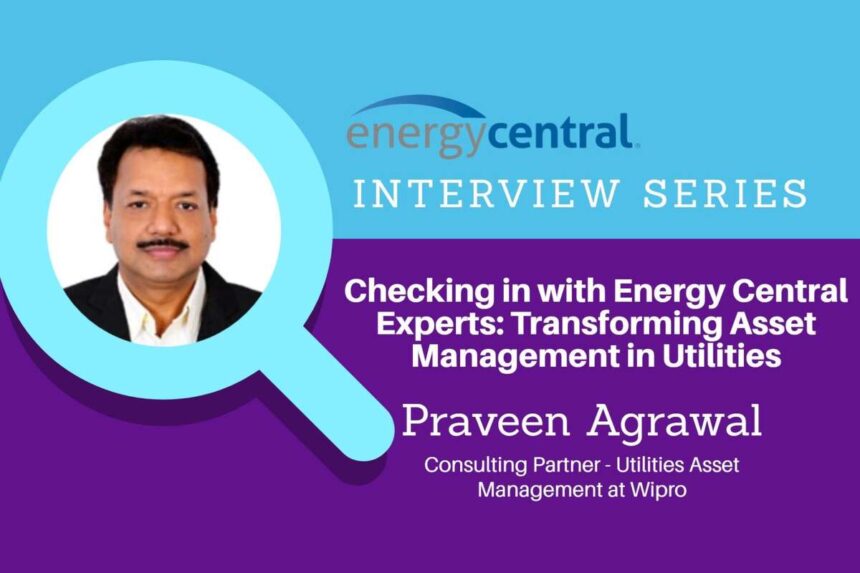In our conversation, Praveen reflects on his extensive journey in the utility sector, his current work on asset data transformation, and the innovative approaches developed by his team at Wipro to model utility asset networks more effectively.
Praveen’s passion for innovation and leadership in asset management is evident as he shares his motivations and the importance of collaborative learning within communities like Energy Central. Read on, and don’t let the conversation end there. If you have follow-up questions or notes for Praveen, leave them in the comments below to keep the discussion going!

Matt Chester: Can you share more about your journey in the utilities sector and what initially drew you to specialize in asset management?
Praveen Agrawal: I began my career 27 years ago on the shop floor of a manufacturing company surrounded by plant assets. Since then, I have focused on asset management. The initial years were primarily in the manufacturing sector, and later on, I transitioned to working for global energy and utilities companies.
MC: Asset data transformation is a key topic today. How do you define it, and why is it crucial for the utilities sector?
PA: Utilities are experiencing significant pressure to optimize their operations due to regulations aimed at reducing waste and carbon footprints. To meet these obligations, they must adopt measures that promote greater control throughout their operations, improve reporting practices, and enable the rapid implementation of necessary changes. At the same time, demand for alternative energy sources is growing, forcing providers to invest in new asset classes and innovate new operating models.
To optimize the performance of legacy and new-age assets (and integrate them with a changing grid), utilities must start treating asset data as an asset in itself and ensure that this data is systematically enriched, managed, and governed throughout their networks and technology stacks.
MC: What innovative approaches have you and your team at Wipro developed to model utilities’ asset networks more effectively?
PA: Wipro has taken the lead in designing and developing holistic data management solutions for utilities. Our offering provides solutions for the complete spectrum of asset data transformation including, maturity assessment, a reference data model aligned to leading industry standards and data architectures, data quality discovery and cleansing solutions, and overall data governance framework.
Specifically, our approach models utilities asset data to represent all dimensions—including engineering, financial, spatial, network, and operational—with mapping to physical data models of leading products, including EAM, GIS, and OT systems.
MC: How do you foresee the role of digital twins and IoT evolving in asset data transformation?
PA: Digital twin and IoT are important concepts and components to be considered as part of overall asset data management processes. When designing asset models for utilities, there should be consideration for open data models for managing complex assets for both static and dynamic parameters. In fact, successful implementation of digital twin needs data identification, data integration, and data management processes. Further, digital twin combines data modeling and ingestion of data from IoT to provide a complete view of the assets.
MC: What are the critical steps utilities should take when embarking on an asset data transformation journey? How can utilities measure the success of their asset data transformation initiatives?
PA: The asset data transformation journey is a three-step process which includes:
- Preparation: Establish a data model, conventions, and policies. Utilities should build a data governance process to establish principles, policies, and data standards, such as conventions for managing asset data so that it is standardized, interoperable, and high quality.
- Operation: Operationalize asset data. Here the focus is on data operations (CRUD operation) and workflows. Data stewards ensure a complete, consistent view of asset data across the organization. The data governance team should establish quality checkpoints/gates to provide a suitable baseline quality for asset data.
- Analytics: Employ data products, findings, and reports to generate insights that will help decision-making.
MC: What motivates you to continue innovating and leading in the field of asset management? How can Energy Central play a role for people looking to stay abreast of these developments?
PA: I’m truly motivated by asset management, especially in utilities going through changes owing to decarbonization, net zero, and EVs. Utilities need help managing these new challenges and solving our customers’ problems excites me.
Further, reaching out to customers, experts, and peers is important for practitioners like me to learn collaboratively from each other and share best practices. Technology is changing very fast, and there is so much to learn and unlearn. A community or platform like Energy Central provides that opportunity to collaborate with all of us working in this area.
________________________________________
Thanks to Praveen for joining me for this interview and for providing a wealth of insights and expertise to the Energy Central Community. Praveen will be available for you to reach out and connect, ask questions, and more as an Energy Central member, so be sure to make him feel welcome when you see him across the platform.
The other expert interviews that we’ve completed in this series can be read here, and if you are interested in becoming an expert, you can reach out to me or you can apply here.




